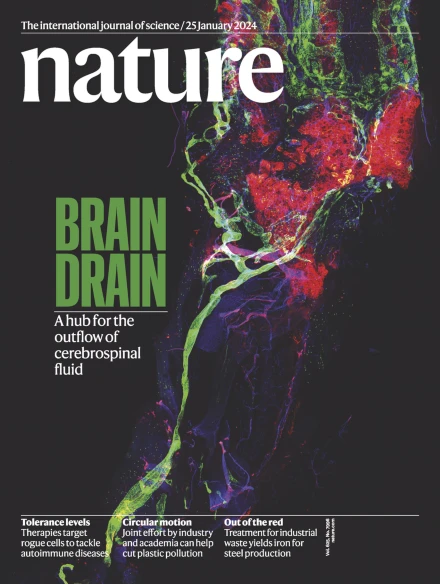Direct observation of coherent elastic antineutrino–nucleus scattering
IF 48.5
1区 综合性期刊
Q1 MULTIDISCIPLINARY SCIENCES
引用次数: 0
Abstract
Neutrinos are elementary particles that interact only very weakly with matter. Neutrino experiments are, therefore, usually big, with masses in the multi-tonne range. The thresholdless interaction of coherent elastic scattering of neutrinos on atomic nuclei leads to greatly enhanced interaction rates, which allows for much smaller detectors. The study of this process gives insights into physics beyond the Standard Model of particle physics. The CONUS+ experiment1 was designed to first detect elastic neutrino–nucleus scattering in the fully coherent regime with low-energy neutrinos produced in nuclear reactors. For this purpose, semiconductor detectors based on high-purity germanium crystals with extremely low-energy thresholds were developed2. Here we report the first observation of a neutrino signal with a statistical significance of 3.7σ from the CONUS+ experiment, operated at the nuclear power plant in Leibstadt, Switzerland. In 119 days of reactor operation (395 ± 106) neutrinos were measured compared with a predicted number from calculations assuming Standard Model physics of (347 ± 59) events. With increased precision, there is potential for fundamental discoveries in the future. The CONUS+ results in combination with other measurements of this interaction channel might therefore mark a starting point for a new era in neutrino physics. Direct observation of coherent elastic neutrino–nucleus scattering is reported using the data from the CONUS+ experiment in which the antineutrinos with energy less than 10 MeV are produced in a nuclear reactor.


相干弹性反中微子核散射的直接观测
中微子是一种基本粒子,与物质的相互作用非常弱。因此,中微子实验通常规模很大,质量在数吨范围内。中微子在原子核上的相干弹性散射的无阈值相互作用大大提高了相互作用速率,从而允许更小的探测器。对这一过程的研究提供了超越粒子物理标准模型的物理学见解。CONUS+实验被设计用于首次探测核反应堆中产生的低能中微子在完全相干状态下的弹性中微子核散射。为此,开发了基于极低能量阈值的高纯度锗晶体的半导体探测器2。在这里,我们报告了在瑞士莱布施塔特核电站运行的CONUS+实验中首次观测到一个统计显著性为3.7σ的中微子信号。在反应堆运行的119天里,我们测量到了(395±106)个中微子,并将其与假设标准模型物理(347±59)个事件的计算结果进行了比较。随着精确度的提高,未来有可能出现根本性的发现。因此,CONUS+的结果与对这一相互作用通道的其他测量相结合,可能标志着中微子物理学新时代的起点。
本文章由计算机程序翻译,如有差异,请以英文原文为准。
求助全文
约1分钟内获得全文
求助全文
来源期刊

Nature
综合性期刊-综合性期刊
CiteScore
90.00
自引率
1.20%
发文量
3652
审稿时长
3 months
期刊介绍:
Nature is a prestigious international journal that publishes peer-reviewed research in various scientific and technological fields. The selection of articles is based on criteria such as originality, importance, interdisciplinary relevance, timeliness, accessibility, elegance, and surprising conclusions. In addition to showcasing significant scientific advances, Nature delivers rapid, authoritative, insightful news, and interpretation of current and upcoming trends impacting science, scientists, and the broader public. The journal serves a dual purpose: firstly, to promptly share noteworthy scientific advances and foster discussions among scientists, and secondly, to ensure the swift dissemination of scientific results globally, emphasizing their significance for knowledge, culture, and daily life.
 求助内容:
求助内容: 应助结果提醒方式:
应助结果提醒方式:


